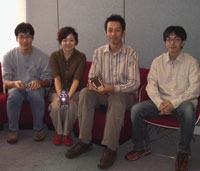1. Introduction
Our research focuses on ubiquitous technologies that present a new approach to visitor's experiences in museums. Museums, including art, history, natural history and science museums; zoos, aquariums, historic sites and arboretums strive to facilitate the learning experience of ever-increasing diverse audience [1] [2]. Today, museum visitors are aware of the role museums can play in their lives. They appreciate the value of objects in museums and expect to actively participate in the museum learning experience [3]. In order to enhance and support museum visitor's learning experience, we designed an educational exhibition guide called ubiNEXT.
2. ubiNEXT
ubiNEXT consists of a server and a PDA terminal (Fig. 1). They provide visitors with Internet and on-site services. The Internet service has two major features, a pre-visit planning and visit review. Pre-visit planning is designed for school teachers and visitors, who would like to personalize their tours before entering a museum. Pre-visit planning users can have an in-depth study of museum collections, and become familiar with objects exhibited in the museum. Visit review offers visitors to continue their museum experience at home or in the classroom. At the museum, the PDA presents object information and educational activities, with interactive text, audio and video. It also presents object locations. When a visitor scans the barcode of an object with the PDA, the related interactive content is delivered from the server and displayed on the screen.
3. The Feature of ubiNEXT - Object Recommendation -
Traditional museum exhibitions are often told with a single story based on a particular theme. Usually in such exhibitions, visitors tend to follow curated courses designed in linear patterns. Our system offers an alternative to such a curated course. It is up to the users to decide to either follow the curated course (curator's featured tour) or explore the museum on their own (user tour). The curator's featured tour highlights museum's collections that are selected by museum curators.
On the user tour, ubiNEXT provides visitors a number of object recommendations in which visitors may be interested in seeing subsequently. ubiNEXT's object recommendation is determined by two major factors. One important factor is the allocation of keywords to each object. ubiNEXT assigns several keywords, such as Impressionism, sculpture, and mythology to each object. If, for example, a visitor was looking at Vincent van Gogh's "Sunflowers" which includes the keyword "Impressionism," ubiNEXT will automatically suggests Claude Monet's "Water Lilies" which shares the same keyword. Such keywords virtually connect different objects exhibited in multiple galleries. The information of objects presented on the PDA changes dramatically according to each keyword. Therefore, it gives visitors an opportunity to encounter various stories based on individual keyword, while allowing them to randomly access the information anytime they want.
Another significant factor of recommendation is the personalization. After learning about exhibited objects shown on the PDA, visitors have an opportunity to express their evaluations on each object. Visitor's personal evaluations and their performances are stored in the system server. ubiNEXT will, then, calculate visitor's personal interests, selects a number of objects that matches their preferences, and gives recommendations. For instance, if a visitor gives a high rating on objects that have the keyword, "Impressionism," ubiNEXT will provide the visitor a tour on the "Impressionism" objects.
4. Learning in Museums with ubiNEXT
What can we expect museum visitors to learn from ubiNEXT? Museum visitors can interact with exhibited objects through educational activities and images displayed on the PDA. Through the interaction, we expect visitors to find new relations among different objects that may seem irrelevant. Also, we encourage visitors to actively engage in the experience by providing information that meets visitor's interests. Furthermore, by using the Internet service, we believe that we can offer visitors a continuous learning experience instead of a single experience.
5. Conclusion
We seek to present a new museum learning experience by utilizing ubiquitous technologies mentioned above. We will carry out a pilot test of ubiNEXT in real museum settings. Our evaluation includes recommendation, personalization, and visitor satisfaction. We examine how the personalized tours can enhance visitor's learning experience and how it matches with individual knowledge-level and learning styles. In addition, we plan to research the Internet service, if the pre-visit planning helped visitors to get the most out of the exhibition during their visit, and if the post visit experience supported the actual visit.
References
| [1] |
Anderson, G., ed. 2004. Reinventing the Museum: Historical and Contemporary Perspectives on the Paradigm Shift. Walnut Creek, Calif: AltaMira Press. |
| [2] |
Falk, J.H., and L.D. Dierking. 2000. Learning from Museums: Visitor Experiences and the Making of Meaning. Walnut Creek, Calif.: AltaMira Press. |
| [3] |
Thomas, S., and A. Mintz, eds. 1998. The Virtual and the Real: Media in the Museum. Washington, D.C.: American Association of Museums. |


